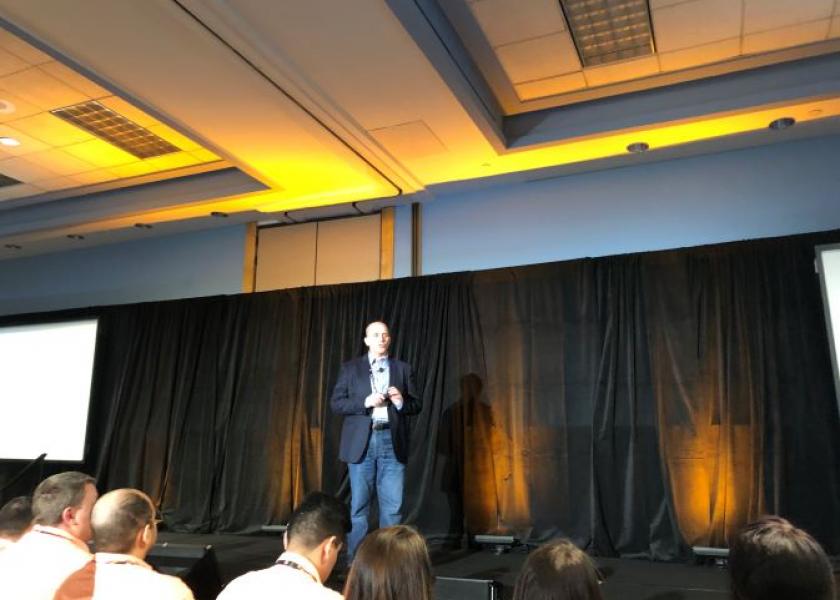Cause marketing is win-win for companies and charities, speaker says

View photos from 2020 SEPC's Southern Exposure here.
TAMPA, Fla. — Corporate charitable giving can be a win-win for both produce marketers and the causes they support, author Joe Waters told attendees at the Southeast Produce Council’s Southern Exposure conference on Feb. 28.
Waters is the creator of a blog called Selfish Giving, specializes in discussions of partnership between nonprofit groups and for-profit companies.
Any company that wants to venture into “cause marketing” to expand their appeal to consumers should first look inward and identify what they value, he said. Finding a purpose for your company for the community and the world that goes beyond profit is part of that process, Waters said.
“Everything that comes after your values is how purpose is executed in the world,” he said. “I think regardless of what you come away with this program today, beginning with charity is definitely the first great step for your organization,” Waters said.
Sponsorship of events is a big trend for companies, he said, and those event sponsorships can be used for marketing purposes. For example, when a shoe company sponsors a marathon race, the company is looking to directly expand its influence with those participants.
Both the nonprofit and the corporation can profit from cause marketing, he said.
“The idea with a cause marketing partnership is about both sides profiting,” he said. Cause marketing has become a “legitimate” part of the marketing mix for companies, he said, and should be considered as an extension of a company’s purpose.
Consumers respond to and want cause marketing from the companies they buy from, particularly important demographic populations of moms and millennial consumers.
Waters estimates “cause marketing” can contribute between 5% and 40% to the overall success of a business.
Companies have a choice whether they want to support a specific nonprofit or work with a broader cause. Some larger brands have their own nonprofit groups they create, such as McDonald’s and its Ronald McDonald House Charities.
Brands can work with charities that may widen their appeal. For example, the beer marketer Stella Artois began work with the nonprofit water.org and attracted younger consumers.
“They found by working with water.org, they became less of an old person’s brand, and so they had a really big result in mind in working with this particular nonprofit,” he said. “And more and more brands are working with nonprofits for that very reason.”
For the produce industry, funding charities with relevant causes — such as feeding children with the Produce for Kids and Brighter Bites charities — makes sense, he said. But there also is room to explore other causes.
Picking what nonprofit to support can be done by executive decision by the CEO, gathering consensus from the company’s employees or letting consumers of the brand have a role in the decision, Waters said. The CEO shouldn’t make the decision without input, he believes.
“If you’re a CEO, and you want to make the decision, you should talk to your employees, you should talk to your customers to decide which nonprofits, which causes you want to work with,” he said. “I think that’s really the best model.”
Produce marketers could also consider the charities their retail chain customers or potential customers are supporting.
Causes that trigger emotion resonate with consumers, he said.
In addition, companies should consider how nonprofit groups communicate with their supporters, he said.
“One of the things you can do is go to the social media sites of nonprofits that you want to work with and look at the size of their (social media) audience and how they are communicating with people,” he said.
Charities that benefit veterans also have a passionate following, he said.
Purchase- triggered donations can sometimes be the “poster child” of bad corporate behavior, he said, citing the example of KFC “buckets for the cure” promotion several years ago with the Susan G. Komen for the Cure foundation. Some critics complained that the anti-cancer group shouldn’t link itself to high-fat foods.
Companies also must avoid ambiguous language with purchase-triggered donations, he said. The U.S. Attorney General’s office is giving greater scrutiny to claims such as “a portion of proceeds goes to cancer causes in your area.” Firms may be prosecuted if nonprofits and business don’t use concrete language related to purchase-triggered donations. Consumer can also be annoyed if they feel the donation related to the purchase is too small, he said.
In the end, Waters said the image of a brand can be shaped by consumer perceptions.
“The truth is your brand what people are saying about you online, and you need to be thinking about that,” he said.
Businesses need to lead with messages on the value of the nonprofit and keep self-promoting marketing to a minimum.
“You want to build that audience into an audience that knows likes and trusts you, and this is why cause marketing is so effective,” he said.
Related articles
Industry must work together to reduce plastic, panel says
SEPC speaker: Women can cultivate connection, self-promote, take risks
Power of Produce session explores impulse buys, buying power and more
Produce for Kids celebrates 2019 success, looks to 2020 plans at SEPC







